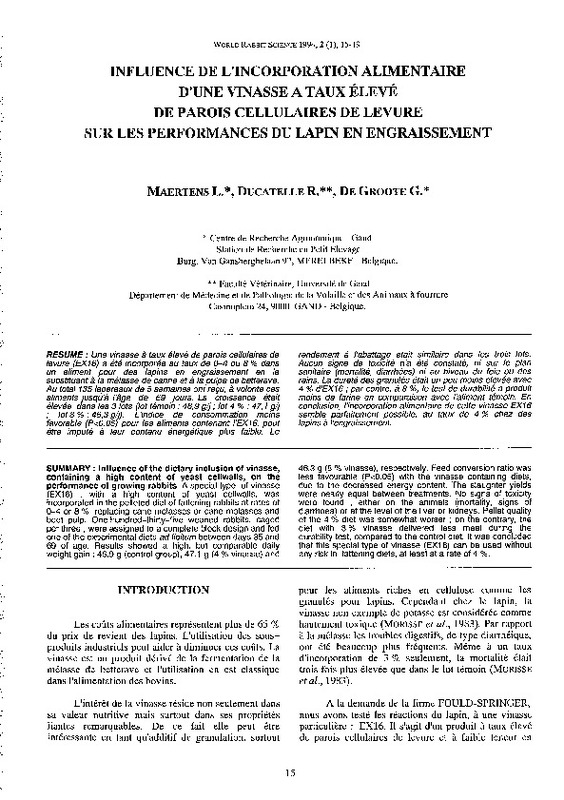JavaScript is disabled for your browser. Some features of this site may not work without it.
Buscar en RiuNet
Listar
Mi cuenta
Estadísticas
Ayuda RiuNet
Admin. UPV
INFLUENCE DE L'INCORPORATION ALIMENTAIRE D'UNE VINASSE A TAUX ÉLEVÉ DE PAROIS CELLULAIRES DE LEVURE SUR LES PERFORMANCES DU LAPIN EN ENGRAISSEMENT""
Mostrar el registro sencillo del ítem
Ficheros en el ítem
| dc.contributor.author | Maertens, L.
|
|
| dc.contributor.author | Ducatelle, R.
|
|
| dc.contributor.author | De Groote, G.
|
|
| dc.date.accessioned | 2011-03-23T11:31:49Z | |
| dc.date.available | 2011-03-23T11:31:49Z | |
| dc.date.issued | 1994 | |
| dc.identifier.issn | 1257-5011 | |
| dc.identifier.uri | http://hdl.handle.net/10251/10547 | |
| dc.description.abstract | [EN] A special type of vinasse (EX16) , with a high content of yeast cellwalls, was incorporated in the pelleted diet of fattening rabbits at rates of 0-4 or 8 %, replacing cane molasses or cane molasses and beet pulp. One hundred-thirty-five weaned rabbits, caged per three , were assigned to a complete block design and fed one of the experimental diets ad libitum between days 35 and 69 of age. Results showed a high, but comparable daily weight gain : 46.9 g (control group), 47.1 g (4 % vinasse) and 46.3 g (8 % vinasse), respectively. Feed conversion ratio was less favourable (P<0.05) with the vinasse containing diets, due to the decreased energy content. The slaughter yields were nearly equal between treatments. No signs of toxicity were found , either on the animals (mortality, signs of diarrhoea) or at the level of the liver or kidneys. Pellet quality of the 4 % diet was somewhat worser ; on the contrary, the diet with 8 % vinasse delivered less meal during the durability test, compared to the control diet. lt was concluded that this special type of vinasse (EX16) can be used without any risk in fattening diets, at least ata rate of 4 %. | es_ES |
| dc.description.abstract | [FR] Une vinasse a taux élevé de parois ce/Ju/aires de levure (EX16) a été incorporée au taux de 0-4 ou 8 % dans un aliment pour des Japins en engraissement en la substituant a la mélasse de canne et a la pu/pe de betterave. Au total 135 lapereaux de 5 semaines ont re9u, a volonté ces aliments jusqu'a l'age de 69 jours. La croissance était élevée dans les 3 lots (lot témoin: 46,9 g/j; lot 4 % : 47, 1 g/j ; lot 8 % : 46,3 g/j). L'indice de consommation moins favorable (P<0.05) pour les aliments contenant l'EX16, peut etre imputé a leur contenu énergétique plus faible. Le rendement a l'abattage était similaire dans les trois lots. Aucun signe de toxicité n'a été constaté, ni sur le plan sanitaire (mortalité, diarrhées) ni au niveau du foie ou des reins. La dureté des granulés était un peu moins élevée avec 4 % d'EX16; par contre, a 8 %, le test de durabilité a produit moins de farine en comparaison avec l'aliment témoin. En conclusion, l'incorporation alimentaire de cette vinasse EX16 semble parfaitement possible, au taux de 4 % chez des lapins a l'engraissement. | |
| dc.language | Francés | es_ES |
| dc.publisher | World Rabbit Science. ICTA. UPV | es_ES |
| dc.relation.ispartof | World Rabbit Science | |
| dc.rights | Reserva de todos los derechos | es_ES |
| dc.title | INFLUENCE DE L'INCORPORATION ALIMENTAIRE D'UNE VINASSE A TAUX ÉLEVÉ DE PAROIS CELLULAIRES DE LEVURE SUR LES PERFORMANCES DU LAPIN EN ENGRAISSEMENT"" | es_ES |
| dc.type | Artículo | es_ES |
| dc.date.updated | 2011-03-23T11:25:02Z | |
| dc.identifier.doi | 10.4995/wrs.1994.212 | |
| dc.rights.accessRights | Abierto | es_ES |
| dc.description.bibliographicCitation | Maertens, L.; Ducatelle, R.; De Groote, G. (1994). INFLUENCE DE L'INCORPORATION ALIMENTAIRE D'UNE VINASSE A TAUX ÉLEVÉ DE PAROIS CELLULAIRES DE LEVURE SUR LES PERFORMANCES DU LAPIN EN ENGRAISSEMENT"". World Rabbit Science. 2(1). https://doi.org/10.4995/wrs.1994.212 | es_ES |
| dc.description.accrualMethod | SWORD | es_ES |
| dc.relation.publisherversion | https://doi.org/10.4995/wrs.1994.212 | |
| dc.description.volume | 2 | |
| dc.description.issue | 1 | |
| dc.identifier.eissn | 1989-8886 | es_ES |








